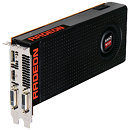- Joined
- Oct 9, 2007
- Messages
- 47,230 (7.55/day)
- Location
- Hyderabad, India
| System Name | RBMK-1000 |
|---|---|
| Processor | AMD Ryzen 7 5700G |
| Motherboard | ASUS ROG Strix B450-E Gaming |
| Cooling | DeepCool Gammax L240 V2 |
| Memory | 2x 8GB G.Skill Sniper X |
| Video Card(s) | Palit GeForce RTX 2080 SUPER GameRock |
| Storage | Western Digital Black NVMe 512GB |
| Display(s) | BenQ 1440p 60 Hz 27-inch |
| Case | Corsair Carbide 100R |
| Audio Device(s) | ASUS SupremeFX S1220A |
| Power Supply | Cooler Master MWE Gold 650W |
| Mouse | ASUS ROG Strix Impact |
| Keyboard | Gamdias Hermes E2 |
| Software | Windows 11 Pro |
Industry sources revealed to TechPowerUp some pretty interesting specifications of AMD's two upcoming GPUs based on the 4th generation Graphics CoreNext "Polaris" architecture. The company is preparing a performance-segment GPU and a mainstream one. It turns out, that the performance-segment chip, which the press has been referring to as "Ellesmere," could feature 32 compute units (CUs), and not the previously thought 40.
Assuming that each CU continues to consist of 64 stream processors (SP), you're looking at an SP count of 2,048. What's more, this chip is said to offer a single-precision floating point performance of 5.5 TFLOP/s, as claimed by AMD. To put this into perspective, the company had claimed 5.2 TFLOP/s for the "Hawaii"/"Grenada" based FirePro W9100, which launched earlier this February, and that SKU featured all 2,816 SP present on the chip. So this chip is definitely faster than most "Hawaii" based SKUs.

While "Hawaii" based SKUs feature TDP of no less than 250W, the new chip has a TDP rated no higher than 150W. AMD could pull off a "single 8-pin power connector" feat like NVIDIA, with quite some headroom to spare. The chip features a 256-bit wide GDDR5/GDDR5X memory interface, and 8 GB could be its standard memory amount. The first SKUs based on this chip could feature 7 Gbps GDDR5 memory.
AMD will upgrade the feature-set to include HVEC/H.265 hardware encode/decode acceleration, DisplayPort 1.3, and HDMI 2.0a outputs.
The smaller "Polaris" chip scheduled for 2016, which the press has been referring to as "Baffin," could feature 14 compute units, working out to a stream processor count of 896. It will be a mainstream chip, succeeding the "Tobago" silicon, which drives the current R7 360 series SKUs, although it wouldn't surprise us if it outperformed bigger chips, such as the "Trinidad" based R7 370 series. This chip has its peak single-precision floating-point performance rated at 2.5 TFLOP/s. Its TDP is rated at just 50W, and it is expected to feature a 128-bit wide GDDR5 memory interface, holding 4 GB of memory.
View at TechPowerUp Main Site
Assuming that each CU continues to consist of 64 stream processors (SP), you're looking at an SP count of 2,048. What's more, this chip is said to offer a single-precision floating point performance of 5.5 TFLOP/s, as claimed by AMD. To put this into perspective, the company had claimed 5.2 TFLOP/s for the "Hawaii"/"Grenada" based FirePro W9100, which launched earlier this February, and that SKU featured all 2,816 SP present on the chip. So this chip is definitely faster than most "Hawaii" based SKUs.

While "Hawaii" based SKUs feature TDP of no less than 250W, the new chip has a TDP rated no higher than 150W. AMD could pull off a "single 8-pin power connector" feat like NVIDIA, with quite some headroom to spare. The chip features a 256-bit wide GDDR5/GDDR5X memory interface, and 8 GB could be its standard memory amount. The first SKUs based on this chip could feature 7 Gbps GDDR5 memory.
AMD will upgrade the feature-set to include HVEC/H.265 hardware encode/decode acceleration, DisplayPort 1.3, and HDMI 2.0a outputs.
The smaller "Polaris" chip scheduled for 2016, which the press has been referring to as "Baffin," could feature 14 compute units, working out to a stream processor count of 896. It will be a mainstream chip, succeeding the "Tobago" silicon, which drives the current R7 360 series SKUs, although it wouldn't surprise us if it outperformed bigger chips, such as the "Trinidad" based R7 370 series. This chip has its peak single-precision floating-point performance rated at 2.5 TFLOP/s. Its TDP is rated at just 50W, and it is expected to feature a 128-bit wide GDDR5 memory interface, holding 4 GB of memory.
View at TechPowerUp Main Site







